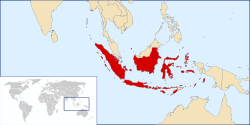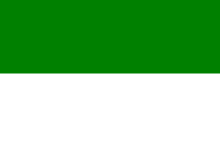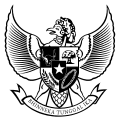United States of Indonesia
| Republic of the United States of Indonesia | ||||||||||||
| Republik Indonesia Serikat | ||||||||||||
| ||||||||||||
| ||||||||||||
| Anthem Indonesia Raya | ||||||||||||
 | ||||||||||||
| Capital | Djakarta | |||||||||||
| Languages | Indonesian | |||||||||||
| Government | Federal parliamentary republic | |||||||||||
| President | ||||||||||||
| • | 1949–1950 | Sukarno Assaat Datuk Mudo (provisional) | ||||||||||
| Prime Minister | ||||||||||||
| • | 1949–1950 | Mohammad Hatta | ||||||||||
| History | ||||||||||||
| • | Established | 27 December 1949 | ||||||||||
| • | Disestablished | 17 August 1950 | ||||||||||
| Currency | Rupiah (IDR) | |||||||||||
| ||||||||||||
The Republic of the United States of Indonesia (Indonesian: Republik Indonesia Serikat, RIS), abbreviated as RUSI, was a federal state to which the Netherlands formally transferred sovereignty of the Dutch East Indies (minus Netherlands New Guinea) on 27 December 1949 following the Dutch-Indonesian Round Table Conference. This transfer ended the four-year conflict between Indonesian nationalists and the Netherlands that was fought over for control of Indonesia. It lasted less than a year, before being replaced by the unitary Republic of Indonesia.
Background
Following pressure from the United States and the United Nations, in particular in the form of a Security Council resolution, the Dutch agreed to negotiations with Indonesia to arrange a transfer of sovereignty. The Dutch–Indonesian Round Table Conference took place in The Hague from August to November 1949. However, many Indonesian nationalists believed that the Dutch had insisted on a federal state in an attempt to weaken or even break up the new nation, a manifestation of a "divide and conquer" strategy[1][2]
Form of state
The RUSI had a bicameral legislature. The People's Representative Council consisted of 50 representatives from the Republic of Indonesia and 100 from the various states according to their populations. The Senate had two members from each constituent part of the RUSI regardless of population, making 32 members in total. The state was governed according to the Federal Constitution of 1949, which had been drawn up on the sidelines of the Round Table Conference. It had a cabinet of 16 members, led by Prime Minister Hatta.[3][4][5]
Dissolution
Over the first half of 1950, the non-Republic states gradually dissolved themselves into the Republic. The United States of Indonesia was officially dissolved by President Sukarno on 17 August 1950 – the fifth anniversary of his proclamation of independence – and replaced by a unitary Republic of Indonesia.[6]
Constituent entities
The RUSI comprised sixteen state entities: a "Republic of Indonesia" consisting of territories in Java and Sumatra (a combined population of over 31 million); and the fifteen states established by the Dutch, which had populations between 100,000 and 11 million.[3]
 Bandjar
Bandjar Banka
Banka Billiton
Billiton Central Java
Central Java East Indonesia
East Indonesia East Borneo (not including former territory of Pasir Kingdom)
East Borneo (not including former territory of Pasir Kingdom) East Java
East Java East Sumatra
East Sumatra Groot Dajak (Dajak Besar)
Groot Dajak (Dajak Besar) Madoera
Madoera Pasundan
Pasundan Republic of Indonesia (Negara Repoeblik Indonesia)
Republic of Indonesia (Negara Repoeblik Indonesia) Riouw
Riouw South East Borneo Federation
South East Borneo Federation South Sumatra
South Sumatra West Borneo (Special Region)
West Borneo (Special Region)
See also
References
Citations
Sources
- Feith, Herbert (2007) The Decline of Constitutional Democracy in Indonesia Equinox Publishing (Asia) Pte Ltd, ISBN 978-979-3780-45-0
- Friend, Theodore (2003), Indonesian Destinies, Cambridge: Harvard University Press, ISBN 0-674-01834-6.
- Kahin, George McTurnan (1970), Nationalism and Revolution in Indonesia, Cornell University Press, ISBN 0-8014-9108-8.
- Indrayana, Denny (2008), Indonesian Constitutional Reform 1999-2002, PT Gramedia, ISBN 978-979-709-394-5
- Legge, J.D. (1964), Indonesia, Englewood Cliffs, New Jersey: Prentice-Hall Inc
- Ricklefs, M.C. (2008), A History of Modern Indonesia Since c. 1200 (4th ed.), Palgrave MacMillan, ISBN 978-0-230-54686-8

